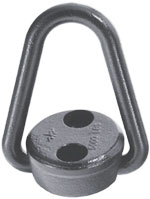
Whether electrically or pneumatically powered, hoists require a special type of load-centering eyebolt. Known as a hoist ring, it’s found on the end of the hoist’s lifting chain or rope. The hoist ring is the fastener to which you can secure a load. You can secure a load to the hoist ring, after which you can use the hoist to lift it.
While all hoist rings are designed to support a load, they are available in many different types. You’ll need to choose the right hoist ring for your lifting application. Below are five things to consider when choosing a hoist ring.
#1) Material
You should consider the material when choosing a hoist ring. Hoist rings are almost always made of metal. The type of metal from which a hoist ring is made, though, may vary. Most of them are made of alloys. Carbon steel is a common type of alloy used in the construction of hoist rings. Other hoist rings are made of stainless steel.
#2) Load Rating
The load rating refers to the maximum amount of weight that a hoist ring can safely support. All hoist rings are designed specifically to secure and lift a load. During production, manufacturers will test their hoist rings to determine how much weight they can safely support. The load rating reflects this maximum weight. Load ratings for hoist rings can range from 500 pounds to over 5,000 pounds.
#3) Swivel vs Pivoting
Swivel and pivoting are two of the most common styles of hoist rings. Swivel hoist rings live up to their namesake by swiveling. They feature a base that’s able to swivel by turning in all directions. Pivoting hoist rings, on the other hand, can only pivot. They can move forward and backward from the base, but they can turn from side to side.
#4) Diameter
Don’t forget to consider the diameter when choosing a hoist ring. The diameter is the width of the hoist ring’s shackle. It reflects the size of the shackle, which is the teardrop-shaped bar that supports a load. The hoist ring needs to feature a wide enough shackle to accommodate the load.
#5) Corrosion-Resistant Finish
When choosing a hoist ring, make sure it has a corrosion-resistant finish. Hoist rings are typically made of an alloy, the most common being carbon steel. Alloys like carbon steel are undoubtedly strong, but they are susceptible to corrosion. Therefore, a corrosion-resistant finish is oftentimes applied over hoist rings.
